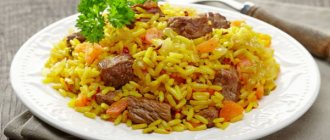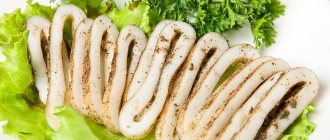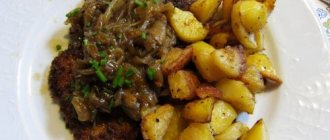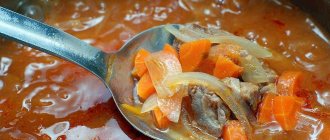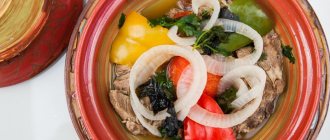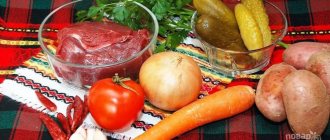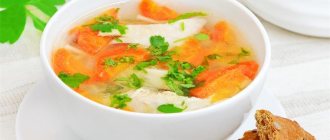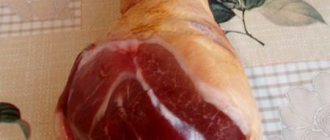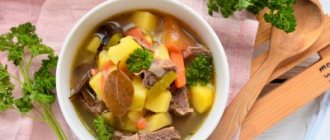Borscht is a truly universal dish: thick, rich, it will warm you up and give you strength during the cold season; light, green - will refresh and quickly nourish you in the heat. And although this dish has been known since ancient times, no two housewives would cook the same borscht.
However, even for the same housewife, on different days it turns out to be different in taste: when the master cook adds fresh tomatoes instead of tomato paste, when she chops bell pepper into the frying dish, when she pours sauerkraut into a saucepan instead of fresh cabbage... That’s why it’s difficult to calculate the calorie content of borscht. However, some numbers can still be derived.
Green or cooked with a lot of beets, lean or with meat broth - any borscht will bring health benefits.
This is a wonderful dish:
- being balanced in composition, it contains almost all the proteins, fats, carbohydrates, vitamins and minerals that a person needs;
- gently envelops the inner walls of the stomach and intestines, helping to cope with chronic gastrointestinal diseases;
- satiating well even with a small portion, it saves you from overeating;
- improves metabolism and promotes the rapid breakdown of carbohydrates and fats entering the body. This process is accompanied by the release of heat. This is why after a plate of borscht it becomes hot;
- Due to the high fiber content in vegetables, it gently cleanses the intestines, removing toxins and heavy metals.
Ideal borscht: studying the composition...
The composition of the dish can indeed include a variety of ingredients, but the basic set is unchanged: potatoes, onions, carrots, beets, tomatoes, white cabbage, greens. From there, everything is limited only by the housewife’s imagination and the selection of products available in the refrigerator.
You can make the borscht more rich by adding boiled beans or fresh green peas to it, acidify the dish with lemon juice or sauerkraut instead of fresh cabbage, cook it with broth from whatever meat you find in the freezer: with chicken, pork, and It’s good with beef, and veal, and rabbit. Bay leaf, allspice and celery root will add flavor to your dish, and a finely chopped clove of garlic will add a piquant flavor.
Green borscht is most often seasonal. It is prepared in the spring with the appearance of the first fresh herbs: wild garlic, sorrel, lettuce. However, nothing prevents you from having a real vitamin holiday in winter using frozen greens. As a rule, beets are not added to this dish and often do without meat at all - finely chopped boiled chicken eggs serve as a substitute.
How to cook borscht with beef: recipe with step-by-step photos
The beef, cut into portions, is boiled for an hour.
In 60 minutes you can get a rich broth. The meat is placed in cold water. You should skim off the foam periodically to keep the broth clear. Peeled and cut into medium pieces potatoes are poured into the broth. The broth is salted and sugar is added at this stage. You should fry the beets cut into strips. After frying, tomato juice is poured into it. It is necessary to wait until the liquid has partially evaporated. The tomato and beets go into the broth. When combined with sour juice, beets retain their original color. The borscht will end up a beautiful red color. Finely chopped onions and chopped carrots are sautéed. At the end, finely chopped garlic is added to the pan. Everything is fried a little until a unique garlic aroma appears. Vegetables are transferred to the cooking borscht.
Cabbage is shredded, bell pepper is chopped. They are added when the potatoes are almost ready. At the end of cooking, add 2 bay leaves, pepper, and herbs. The borscht should simmer for a short time to transfer the aroma of spices to the finished dish.
Homemade beef borscht, simple, quick and delicious! Bon appetit!
Borscht with beef has become a truly international dish. We will look at step-by-step recipes with photos of this rich first course, as well as its energy value, in our article. Believe me, you can eat delicious food without gaining extra pounds!
...and determine the calorie content
Based on the composition of the dish, you can determine its calorie content.
For example, 100 grams of lean borscht cooked in vegetable broth contains only 30 kcal, so those who are uncompromisingly struggling with excess weight can safely include this dish in their diet. A little more - about 37 kcal per 100 grams - contains lean green borscht.
This is explained by the fact that the ingredients of green borscht include chicken eggs and sour cream, which are very high-calorie foods. However, be careful: the same vitamin borscht, cooked in a rich bone broth with meat, will add as much as 187 kcal per 100 grams of product!
But the calorie content of red borscht in meat broth depends on what type of meat was used. For example, the calorie content of borscht with beef will be 87 kcal per 100 grams of product.
The calorie content of borscht with chicken may vary depending on the form in which you cook the bird. Only 34 kcal per 100 grams of dish - provided that the skin is removed from the chicken, and as much as 50 kcal per 100 grams of the first course cooked with chicken with the skin. Nevertheless, chicken meat continues to be one of the most dietary, and therefore often ends up on the plate.
You need to be most careful with pork. Pork meat is usually fatty, which is why the food cooked with it is not at all light - 164 kcal per 100 grams of product.
Therefore, if you adhere to a strict diet - due to illness or to lose weight - it is better to avoid borscht with pork. A dish with pork will successfully replace its counterpart with beef or chicken.
Borscht - calories
Borscht is a tasty and healthy first course, which was originally the main dish of Ukrainian cuisine, but today it is also loved by representatives of other nations. Rich borscht has a wonderful taste, so its calorie content is mainly of interest only to those losing weight.
Borscht – multi-ingredient soup
In the old days, the calorie content of borscht was not a disadvantage, but an advantage, because... One plate of this dish was enough to fill you up and fill your body with energy for a long time. Over time, the composition of borscht has changed, and its calorie content has also changed; today many new recipes have appeared, including even dietary borscht for weight loss.
Any type of borscht is a perfectly balanced dish that successfully combines nutrients - proteins, fats and carbohydrates, as well as essential vitamins and minerals. Thanks to its composition, borscht improves the functioning of the liver and the entire digestive system, stimulates metabolic processes, and promotes the removal of toxic substances.
Modern borscht is prepared with the obligatory use of beets, which gives it an excellent taste and an appetite-stimulating color. In addition, the ingredients of most recipes are meat (beef, chicken, pork) and vegetables (potatoes, onions, cabbage, carrots, tomatoes). In different regions, borscht is enriched with additional ingredients - beans, zucchini, bell pepper, turnips. Spices add a special piquancy to the dish; most often allspice, red or black pepper, bay leaf, celery, dill, parsley are added to borscht; lovers of unusual tastes can add tarragon, thyme, basil, and marjoram. To find out how many calories are in a plate of borscht, you need to take into account all the components of this dish and the method of preparing it.
Classic borscht is prepared in several stages. First you need to put the meat on the boil - it will cook for 1.5-2 hours, then other components are added to the broth, first of all - potatoes and cabbage (for Ukrainian borscht, cabbage is added last so that it remains crispy). To preserve the red color, beets should be stewed with some kind of acid (citric, acetic) before adding to the pan. Onions and carrots are also sautéed separately, then tomato paste or fresh peeled tomatoes are added to them. The calorie content of 100 g of classic borscht with beef is approximately 100-110 kcal, but it should be remembered that a serving of this delicious soup is usually much larger - up to 500 g.
Calorie content of various borschts
The calorie content of borscht depends on its variety and the ingredients that are added to it. The highest calorie content is borscht made with meat, especially pork - about 200-210 kcal per 100 g. The calorie content of vegetarian, mushroom and green borscht is not so high - from 25 to 75 kcal.
Cold green borscht is an excellent light dish for the summer heat. It is prepared not with meat broth, but with beet broth, so its calorie content is minimal - about 25-30 kcal. First, the beets, cut into cubes, are boiled in water acidified with vinegar. Finely chopped boiled eggs, potatoes, cucumbers, green onions, parsley, dill, and salt are added to the cooled broth. Cold borscht is served with sour cream.
How can you reduce the calorie content of borscht?
You can reduce the calorie content of the dish by choosing leaner meat - take beef or chicken instead of pork. Try using beans instead of potatoes. By not pre-frying the onions and carrots, you will also make the borscht a less heavy dish. You can prepare a delicious first course without stewing beets - in this case, you will not only reduce the amount of oil, but also avoid adding vinegar. With this method, the beets need to be peeled and boiled together with the meat. After the borscht is almost ready, remove the beets from the pan, chop or grate them, add them back to the soup, and immediately after boiling, turn off the heat (this is necessary to preserve the red color).
Reducing the calorie content of borscht: a note for the housewife
If you really love this wonderful dish and are not at all ready to give it up, but you also want to maintain a slim figure, remember these simple tricks:
- fry vegetables in a minimum amount of vegetable oil, and if you have a non-stick frying pan, avoid oil altogether;
- cook the broth with meat, and not with a meat bone: this way you are guaranteed to save yourself from extra calories;
- borscht cooked with fresh cabbage will be much lower in calories than one cooked with sauerkraut;
- the fewer potatoes in the dish, the better for your figure;
- instead of mayonnaise as a dressing, you can use low-fat sour cream or abandon it altogether;
- It is better to serve a plate of aromatic dish with black or gray bread, but not white bread: rye baked goods are better suited to taste, and they contain fewer calories than wheat baked goods.
Greetings, dear readers! Today we’ll talk about the principles of preparing such an amazingly popular dish as borscht.
For any person, the most delicious food is the one to which he has become accustomed since childhood. For Russians, borscht is not just food, it is a real cultural heritage. We will now talk about this “significant” dish.
Borscht is a truly universal dish. Today it is often served as a first course.
It gives strength, warms in cool weather, refreshes in hot weather. And although it has been prepared since ancient times, there are no housewives who would cook it the same way. Even one cook can prepare it in different ways, for example, replacing tomato paste with fresh tomatoes or putting sauerkraut in a pan. For this reason, the calorie content of this dish is difficult to determine.
In many countries they prepare borscht. It is also eaten by those who watch their figure. Among the many dish options, everyone can choose the most suitable one.
Benefits of the dish
Boiled with beets, without meat,
green - borscht will in any case be beneficial for the body. This balanced dish contains many vitamins and minerals, it helps to cope with gastrointestinal diseases, saturates even a small portion, improves metabolism, and carbohydrates, fats and proteins entering the body are quickly broken down. During digestion, heat is released, which is why it becomes hot after eating a portion of borscht.
Just as it is impossible to imagine cabbage soup cooked without cabbage, there is no borscht without beets. Other ingredients may be added or omitted, but the broth and beets are always present.
The dish may contain various ingredients, but potatoes, onions, carrots, beets, cabbage, and herbs are required. The options for this dish depend on the imagination of the cook and the availability of products. You can make the broth more rich by boiling it with pork. Garlic will add piquancy to the dish. Borscht must be acidified; vinegar or cabbage brine is used for this purpose. It is also worth including sugar in the recipe, which will give the dish a sweetish taste. This soup is prepared with both boiled and raw beets. It is cut into strips, vinegar is added and fried with oil.
Processing of this vegetable is necessary so that when stewing it does not lose its rich burgundy hue. Then add broth, sugar, tomato paste or fresh tomatoes to the beets, cover with a lid and simmer over low heat. Shortly before the end of the stewing, add the fried roots and onions. The broth is cooked separately, so that it is transparent, it is necessary to remove fat and foam from its surface. Fresh shredded cabbage is added to the soup, and after boiling, stewed beets and roots are added to it, continuing cooking for about another half hour. At the end of the cooking process, add browned flour, various spices, as well as salt and sugar to the borscht and boil for 10 minutes. If sauerkraut is used in the preparation of borscht, it is first stewed.
Lenten borscht
Vegetarian borscht is made in the same way, but vegetable broth is used for this. To increase the nutritional value, beans are sometimes added to it. Vegetable broth does not affect the taste and will not harm the figure. For this reason, many women love vegetarian borscht - there are few calories, and in terms of its usefulness it is not inferior to the traditional version.
Cold borscht
This borscht is also called okroshka, since they have much in common in the method of preparation. Pre-boil the beets, potatoes and eggs, then cut them into cubes. Cucumbers and greens are cut and added to the prepared vegetables. Instead of boiled meat, pork, beef tongue or sausage are sometimes used. The significant difference between cold borscht and okroshka is that it is prepared with beetroot broth, which gives it a rich raspberry hue and a unique taste. This dish is most often made in the summer, when it is difficult for the body to digest heavy food.
How to determine the calorie content of borscht?
Its nutritional value depends on the composition of the dish. Thus, lean borscht, which is cooked in vegetable broth, can be safely consumed by people who are watching their figure, since its calorie content is only 30 kcal. The calorie content of borscht with beets, which is cooked in meat broth, depends on the meat. If borscht was cooked with beef, then its nutritional value corresponds to approximately 90 kcal.
What are the benefits of the ingredients?
Borscht contains such a healthy vegetable as beets. It has a laxative effect and has a beneficial effect on digestive processes. Another healing component of this soup is onion. It stimulates the immune system and accelerates metabolism. Poultry meat is considered dietary, so the nutritional value of borscht with chicken or turkey will be low. Protein from poultry meat is easier to digest, and digestion occurs without complications for the gastrointestinal tract. Many doctors recommend chicken broth during the recovery process after illnesses and operations.
Cooking green borscht
Healthy food lovers will love green borscht. The classic recipe with beef is so simple that even an inexperienced housewife can master it.
Compound:
- 0.5 kg beef;
- 300 g sorrel;
- 2.5-3 liters of purified water;
- refined vegetable oil;
- 2-3 potatoes;
- carrot;
- 2 eggs;
- salt;
- seasoning blend
Preparation:
Calorie content of borscht:
50 kcal* *average value per 100 grams, depends on the composition of ingredients and method of preparation
A healthy diet is not complete without hot first courses. When choosing between soups, broths and borscht, it is important to pay attention to the energy value of the dishes.
How to reduce calories?
- Fry vegetables adding minimal oil.
- It is better to cook broth with meat.
- If you cook broth with chicken without adding oil, the calorie content of the dish will decrease.
- Borscht with fresh cabbage is less nutritious.
- Place a minimal amount of potatoes in the dish.
- For dressing, use low-fat sour cream, not mayonnaise.
It is known that during frying the nutritional value of foods increases, especially when using animal fats. When stewing, beneficial substances are preserved, thus, food processed in this way is deprived of a minimum amount of vitamins.
There are no contraindications for consuming borscht, regardless of individual intolerance to its individual components. In general, like most first courses, borscht has many useful qualities. Among them, it is worth noting such an ability as normalizing the functioning of the digestive organs and calming the irritated gastric mucosa. In addition, this dish affects metabolism.
Borscht is the first dish eaten in Eastern Europe. It has Ukrainian roots and stands out for its bright color and rich taste. Classic borscht is prepared with meat broth; the required ingredients are beets, potatoes, cabbage and tomatoes.
How many calories are in different types of borscht?
Let's start by determining the calorie content of classic borscht. cooked without meat, has a calorie content of 30 kcal per 100 grams. without skin - 35 kcal per 100 grams, with skin - 52 kcal per 100 grams. If the dish is prepared with beef or its calorie content increases at least 2 times. The calorie content of borscht with beef is 86 kcal per 100 grams, with lean pork - 105 kcal, with fatty pork - as much as 160 kcal per 100 grams. But the fattest is borscht with lard, its calorie content is 189 kcal per 100 grams.
Let's move on to the calorie content of green borscht. Lean green borscht has a calorie content of 37 kcal, but beef borscht will cost 95 kcal. The calorie content of green borscht with pork will be 166 kcal per 100 grams.
Of course, it is worth considering that the calorie content of borscht depends on the amount of meat, vegetables and other additives in it.
Calories in beef broth
To calculate the calorie content of any dish, you need to take into account the energy value and quantity of all components included in the recipe. To determine the calorie content of borscht with beef broth, you need to know, first of all, the composition and main indicators of the broth itself.
Beef broth made from two types of meat products - trimmed, cleaned meat or bone. The calorie content of beef borscht broth can be reduced by draining the first broth. In addition to reducing the energy value, this procedure allows you to achieve purity and transparency of the finished broth, and also eliminates the need to remove foam when boiling meat.
If we take into account that a 3-4 liter pan of borscht requires about 1 kg of beef, then the finished broth will have a calorie content of 100 g:
- bone broth (shank or shoulder) – about 25 kcal;
- meat broth (trimmed shank) - about 30 kcal.
The nutritional value of bone and meat broth also has some differences and is:
- meat broth – proteins 2.3 g, fats 1.10 g, carbohydrates 2.6 g;
- bone broth – proteins 4 g, fats 1.3 g, carbohydrates 0.2 g.
What is the calorie content of a plate of borscht?
We figured out the calorie content of borscht per 100 grams of ready-made dish. But this is not entirely convenient for calculations. Therefore, now we will talk about the calorie content of 1 plate of borscht.
It’s worth noting right away that the sizes of the plates vary. On supermarket shelves you can find both giant plates that hold 500-600 milliliters of liquid, and small plates with a volume of only 200 milliliters. Therefore, to know exactly the capacity of your plate, fill it with water, and then pour the water into a measuring glass (you can do it in several steps), then you will know exactly how much liquid your dish can hold and what the calorie content of a plate of borscht is.
For example, let's take a standard portion (300 grams). Accordingly, the calorie content of a plate of borscht (classic) will range from 90 to 550 kcal. But if you decide to add sour cream or toasted crackers to the borscht, the calorie content will increase in accordance with the calorie content of the additives. Therefore, we strongly recommend that people who are on a diet or have heart problems do not overuse rich borscht with various high-calorie additives.
The calorie content of a standard plate of green borscht ranges from 110 to 515 kcal. Follow the same rule here. Do not overeat fatty foods. It will not benefit your body, but will only complicate the work of the heart, contribute to the formation of blood clots and blockage of blood vessels.
The benefits and harms of borscht
We've talked about the calorie content of borscht, now it's worth talking about its benefits. This dish has a whole range of microelements. Vitamins B1, B2, C, organic acids, folic acid, mineral salts - all these useful substances are contained in borscht.
Here we come to the results. Should you eat borscht if you are losing weight? It's up to you to decide, of course. But given the nutritional value, a large number of useful microelements, vitamins, and borscht can and should be included in your diet at least several times a week. The calorie content of a plate of borscht with chicken is not that high, but this dish is maximally balanced in terms of the ratio of proteins, fats and carbohydrates, and has a positive effect on the functioning of the gastrointestinal tract, heart, kidneys and liver.
“Borscht and porridge are our food,” says a popular saying. Indeed, this first dish has long gained popularity among millions of housewives. Today, borscht is so loved and entrenched in many families as a healthy, tasty, and most importantly affordable and easy-to-prepare dish that it has become practically an integral part of the menu of our population. So, what is included in borscht? This dish includes:
- cabbage;
- beet;
- beef or pork meat;
- tomatoes;
- carrot;
- garlic;
- pepper;
- Bay leaf;
- tomato paste;
- beans;
- greenery.
Today, no one doubts the benefits of such a first course; the questions that we increasingly receive are usually the following: “What is the calorie content of borscht?”, “Is it possible to lose weight with borscht?”, “I love borscht, does its calorie content bother me?” , “If you cook some borscht without meat, will its calorie content become lower?” “Please tell me how many calories are in borscht?” and other similar questions. We are happy to answer them. So…
Calorie content of borscht with beef per 100 grams
The following products were taken for calculation:
- 1 g lemon juice;
- 17 g beets (boiled);
- 11 g cabbage (boiled);
- 7 g onions;
- 7 g sour cream;
- 56 g beef broth.
| Name | Weight |
| Calorie content | 32 kcal |
| Fats | 1.64 g |
| Carbohydrates | 3.37 g |
| Squirrels | 1.37 g |
| Sodium | 202 mg |
| Calcium | 19 mg |
| Iron | 0.28 mg |
| Potassium | 118 mg |
| Vitamin C | 3.7 mg |
How many calories are in one bowl of borscht?
Products taken for calculation:
- 2 g lemon juice;
- 43 g boiled beets;
- 27 g boiled cabbage;
- 18 g boiled onions;
- 17 g sour cream;
- 138 g beef broth.
| Name | Weight |
| Calorie content | 78 kcal |
| Fats | 4.02 g |
| Carbohydrates | 8.26 g |
| Squirrels | 3.36 g |
| Sodium | 495 mg |
| Calcium | 47 mg |
| Iron | 0.69 mg |
| Potassium | 289 mg |
| Vitamin C | 9.1 mg |
This delicious and healthy borscht!
As you know, borscht is very rich in beets and cabbage. In addition, borscht contains a lot of useful vitamins, minerals, amino acids, healthy fatty acids such as Omega 3 and 6, protein, plant fiber and everything that can be beneficial for health. Therefore, borscht is also considered a medicinal food and is indicated for obese patients (only borscht prepared with lean beef) and overweight people. It is also recommended to eat borscht for people suffering from anemia, vitamin deficiency, diseases of the liver, biliary tract, kidneys, as well as cardiovascular diseases (garlic, beets and cabbage - all this perfectly cleans the walls of blood vessels) and a number of other diseases.
In addition, with the systematic consumption of borscht, metabolism is normalized. Now let's move on to the immediate question about borscht and calories.
How many calories are in borscht...
Borscht calorie table
| Borscht made with fresh cabbage | 100 grams | 116 Kcal |
| Borscht made from sauerkraut | 100 grams | 156 Kcal |
| Ukrainian borsch | 100 grams | 90 Kcal |
| Borscht cooked on the bone with herbs | 100 grams | 168 Kcal |
| Borscht cooked with beans | 100 grams | 67 Kcal |
| Borscht cooked without meat | 100 grams | 57.3 Kcal |
It turns out that cold borscht contains twenty fewer calories.
The calorie content of borscht will also depend on the choice of meat - if it is lean beef, then the calorie content will be lower than if you cook borscht with pork. The beans in borscht also promote satiety and weight loss, since beans contain virtually no carbohydrates and are a low-calorie food rich in protein. In fact, borscht contains few calories, so it is also considered a medicinal dish.
If we talk about potatoes, then in order not to gain extra pounds, you should not put a lot of potatoes in the borscht.
And the last thing! Borscht is a wonderful first dish, which, thanks to the content of valuable ingredients, is a source of vitality, good health and beauty. So eat borscht and forget about those extra pounds! Good luck!
Lyudmila D. was with you.
Borscht calorie table
To make it easier to navigate the calorie content of various interpretations of this first dish, use the table:
| Borsch | Calorie content per 100 g (kcal) |
| With porcini mushrooms | 20 |
| Siberian | 48 |
| Cold summer | 49 |
| Ukrainian | 49 |
| With sorrel and bulgur | 35 |
| With pork stew | 35,9 |
| With minced chicken and broccoli | 78,8 |
| With chicken in the oven | 47,5 |
| With beans without meat | 65,1 |
| Pork ribs with boiled beans | 67,2 |
The use of borscht in dietetics and for weight loss
Classic borscht, cooked in meat broth and seasoned with sour cream, can be called dietary at a stretch. However, vegetarian recipes for this dish fit well into the concept of nutrition for weight loss. So, lean borscht is acceptable when eating on the Pyaterochka diet. If you cook a similar first dish in vegetable broth and add celery, you will get an option suitable for the Finnish diet.
There is a special weekly “borscht” diet, which nutritionists speak very positively about. It is balanced and provides the body with the necessary substances.
Classic recipe
The most popular option is the Ukrainian version of this first dish. It is prepared on pork ribs or shoulder. Ingredients:
- meat – 680 g;
- potatoes - 3 large tubers;
- beets – 1 pc. (small);
- cabbage – 200 g;
- pepper – 2 pcs.;
- carrots – 2 pcs.;
- lard - about 20 g;
- tomatoes – 4-6 pcs.;
- onions – 2 pcs.;
- garlic, herbs, spices.
Preparation:
- Rinse the meat and bring it to a boil with three liters of water. When the broth boils, drain it, add three liters of water again and simmer over low heat for three hours. An hour after starting, add coarsely chopped carrots (one) and an onion cut in half. It is better to salt the broth at the very end.
- Strain the finished broth, set the meat aside to cool, and discard the carrots and onions. To make the borscht taste more “tomato-like,” you can boil one small tomato in the broth without cutting it. After this, the tomato is thrown away.
- Chop the potatoes into cubes and add them to the boiling broth.
- Cut the cabbage into small strips and add ten to twelve minutes after adding the potatoes. It should boil for about ten minutes.
- Separate the meat from the bones and place in the borscht.
- Peel the beets, onions and carrots. Cut the beets into strips (you can grate them coarsely). Simmer it in a hot frying pan. After a couple of minutes, add the diced onion to it, and after the same amount, grate the carrots on a medium grater.
- When the vegetables turn golden brown, add the finely chopped bell pepper.
- Pour boiling water over the tomatoes, peel the skin and finely chop. Add them to the dressing two to three minutes after the pepper.
- Keep the dressing on the fire for about four to five minutes, then pour into the borscht. It should boil for five minutes, after which pepper the dish and season it with lard, which is first ground in a mortar with a clove of garlic.
Serve this borscht with sour cream, sprinkled with herbs on top.
Calorie content
This Ukrainian borscht with meat is about
150-200 kcal in an average serving
(about 120 g). By replacing pork with beef or duck, you can reduce this figure.
Borscht with vinegar
- Pour water over the meat and cook for 1.5 hours.
- Then cut the meat into small pieces and add to the broth.
- Chop the cabbage into thin strips.
- Finely chop the onion.
- Grate the carrots on a medium grater.
- Cut the beets into thin strips.
- Cut the potatoes into cubes or wedges.
- Fry the beets in vegetable oil.
- Add vinegar and tomato paste (if the paste is thick, add a little water), simmer for 5-7 minutes.
- Fry the onion in vegetable oil.
- Add carrots and fry.
- Add potatoes to the boiling broth and add salt.
- When the broth boils, add cabbage. Cook over low heat for 5 minutes.
- Add beets, cook for about 10 minutes.
- Add onions and carrots.
- Then add bay leaf and parsley root. If necessary, add salt and pepper.
- Add garlic squeezed through a garlic press.
- Remove from heat and let steep for 15-20 minutes.
- Pour the finished borscht into bowls, add sour cream and sprinkle with herbs.
- Beef meat – 500 gr.
- Potatoes – 250 gr.
- Fresh cabbage – 150 gr.
- Beets – 200 gr.
- Carrots – 100 gr.
- Onions – 100 gr.
- Water – 2.5 l.
- Tomato paste – 1.5 tbsp.
- Vinegar (it is better to use 6%) – 0.5 tsp.
- Garlic – 2 teeth.
- Bay leaf – 2 pcs.
- Vegetable oil – 3 tbsp.
Nutritional value of the dish “Borscht with vinegar” (per 100 grams):
Source: Borscht with vinegar Pour water over the meat and cook for 1.5 hours. Then cut the meat into small pieces and add to the broth. Chop the cabbage into thin strips. Finely chop the onion. Carrots https://www.calorizator.ru/recipe/137
Other cooking recipes
If in winter the classic version of borscht is more relevant, in summer it is better to give preference to cold varieties of this dish. There are many of them, for example Lithuanian or fish. But in the spring you should definitely treat yourself to green borscht, which does not contain the usual tomatoes.
It is prepared in the same way as classic borscht, but in this case they use not pork, but beef, for example, a shoulder blade on the bone. Ingredients:
- beef – 750 g;
- onions – 2 pcs.;
- tomatoes – 5-6 pcs.;
- potatoes – 4 pcs.;
- carrots – 1-2 pcs.;
- cabbage – 220 g;
- beets - one medium;
- pepper – 2 pcs.;
- garlic, herbs, spices.
Preparation:
- Boil the washed beef in 3.5-4 liters of water; in the middle of cooking, add an onion, cut in half, and coarsely chopped carrots. After an hour and a half, add salt to the broth, after 15 minutes, turn it off.
- Remove the meat and cool. It should be cut into small pieces.
- Potatoes should be cut into cubes and poured into boiling broth.
- Finely chop the cabbage and add to the potatoes. If it is young, 5 minutes is enough for it to be ready; for winter varieties, about 15.
- Grate the beets and simmer in a frying pan. Add to it alternately chopped peppers, grated carrots, and onions.
- Peel the tomatoes, cut into cubes and add to the pan. Simmer the dressing until the vegetables are ready.
- Add meat to pan.
- Pour the dressing into the borscht and simmer the dish for about five minutes. Add salt if necessary, season, add bay leaf.
- After turning off the borscht, add chopped garlic and sprinkle with herbs.
This borscht made with beef broth has a lower calorie content.
than pork -
about 80 kcal in every 100 g.
It can be included in non-strict diets.
This dish is even more dietary. To reduce calories, use the breast or legs with the skin removed. Ingredients:
- beets – 150 g;
- chicken – 550 g;
- carrots – 1 pc.;
- potatoes – 3 pcs.;
- pepper – 2 pcs.;
- cabbage – 150 g;
- tomatoes – 3-4 pcs.;
- onion – 1 pc.;
- greens, pepper.
Preparation:
- Boil chicken in 2 liters of water, add broth at the end.
- Remove the meat and divide into pieces.
- Add diced potatoes to the boiling broth.
- Finely chop the cabbage and add to the dish after 10-12 minutes.
- Prepare the dressing: peel the vegetables and simmer them in a frying pan, adding them in the following order: beets (finely chopped or coarsely grated); sweet pepper pieces; chopped onion, grated carrots, peeled tomatoes (diced).
- Add chicken meat to the borscht. Add the dressing and let the dish simmer for about three to five minutes. Season with pepper and add bay leaf. Add some greens to a plate.
This kind of borscht in meat broth with chicken is quite acceptable even with not too strict diets: its calorie content per 100 grams
varies between
42-65 kcal
(this depends on the meat).
Lithuanian borscht recipe
Ingredients:
- kefir – 300 g;
- potatoes – 3-4 pcs.;
- beets – 100 g;
- egg – 1 pc.;
- spices.
Preparation:
- Boil the beets, then cut into strips, after peeling them.
- Pour a little (about 100 g) water into kefir, add salt and pepper, and stir. Pour it over the beets and sprinkle with herbs. Place half a boiled egg on a plate.
- Boil the potatoes, cut into slices, and serve with borscht as a side dish.
This dish is perfect for hot days. At the same time, calorie content
Lithuanian cold borscht is
about 64 kcal in every 100 grams of the dish.
This dish will appeal to those who fast or are vegetarians. In addition, this borscht is low in calories, so it will be a good addition to the diet menu. Ingredients:
- cabbage – 320 g;
- onion – 270 g;
- vinegar - tablespoon;
- carrots – 170 g;
- beets – 160 g;
- garlic, parsley, pepper, dill, salt.
Preparation:
- Start by preparing the beets: grate them coarsely, simmer them in a frying pan, adding a little water. At the end of stewing, add vinegar (this will preserve the color).
- Peel the onions and carrots, cut into smaller pieces, and fry in vegetable oil.
- Boil 2 liters of water.
- Finely chop the cabbage and add to a saucepan with water.
- After seven minutes, add the beets, and after another 3-4, add the carrots and onions.
- Boil for about twenty minutes, season with pepper.
- When serving, sprinkle with herbs.
Calorie content
This lean or vegetarian borscht without meat is
about 27-32 kcal in every 100 g.
Fish borscht
This dish can also be prepared using lean fish broth. Serve it properly chilled. This dish is cooked in almost the same way as classic borscht, but there are several nuances:
- It is better to choose river varieties of fish, for example small perches, pike;
- They are lightly fried before being immersed in the broth;
- Cooking the broth is enough for a quarter of an hour;
- After the potatoes, pre-cooked beans are added to the borscht.
This cold borscht is low in calories - about 62-75 kcal per serving.
, volume 100 grams.
Green borscht
Ingredients:
- onion – 1 pc.;
- sorrel - about 70 g;
- pork – 270 g;
- egg – 5-6 pcs.;
- potatoes – 4-5 pcs.
Preparation:
- Boil the meat in two liters of water.
- Add diced potatoes to the broth.
- Finely chop the onion and simmer in a frying pan until golden brown.
- Boil and chop the eggs. Add them when the potatoes are ready.
- Wash the sorrel, chop finely and add to the dish. The borscht should simmer for 5-6 minutes.
Serve this dish warm with a spoonful of sour cream on the plate. This green borscht is very healthy, and its calorie content is about 90 kcal for every 100 g of dish.
There are a huge number of variants of borscht, and almost every housewife has her own secrets and recipes. By preparing this dish in clear broth, you can easily use it in your diet menu. How do you cook borscht? Share your recipes in the comments.
